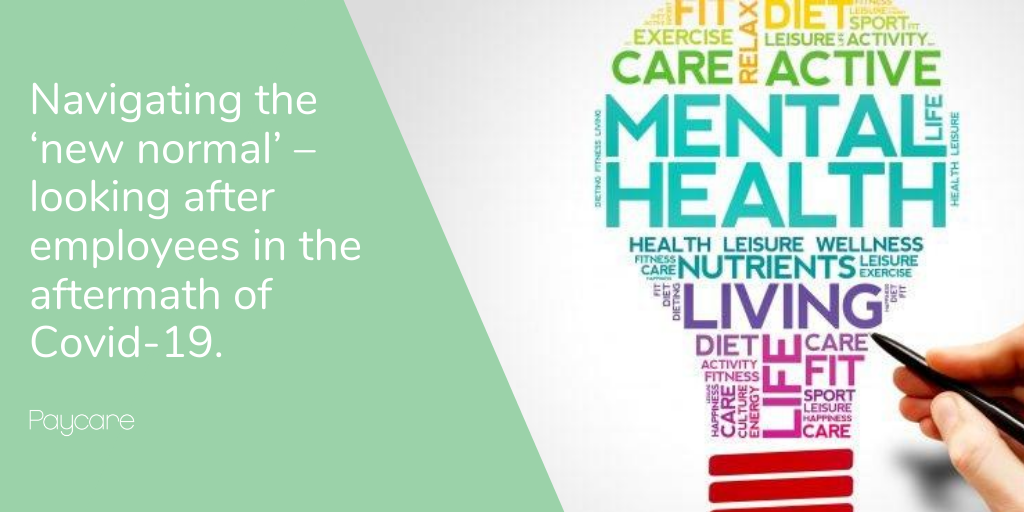Every July, Samaritans branches across the UK host events and raise awareness for their annual Talk to Us campaign – focused on the services they offer within their communities alongside the wider aim of reducing the stigma around mental health conversations1.
This year, it seems especially key for us all to be talking about our emotional wellbeing, in light of the huge upheaval we’ve seen in our professional and personal lives. As we navigate the shift from crisis and lockdown into the ‘new normal’ – still unsure of the exact details of what that might look like for us all – it’s important that the right systems are in place to support employees through the next phase of the pandemic.
The long-term impact of Coronavirus on the nation’s mental health cannot be underestimated: recently, a Mind survey of 16,000 people revealed 65% of adults over 25 (and 75% of young people) who had existing mental health problems had experienced a worsening of their symptoms during the pandemic. And 22% of people who previously had no experience of mental health illness reported their current mental health was ‘poor’ or ‘very poor’2.
This is hardly surprising given the months of lockdown, healthcare worries, potential financial disruption and loss of jobs that people have faced, in fact psychologists suggest quarantine can ‘cause a number of negative effects including symptoms of post-traumatic stress, anger and confusion’3.
But there are a number of ways employers can look to mitigate the impact and play their role in ensuring this transition to the ‘new normal’ takes as small a toll on employee wellbeing as possible…
Let’s take a read!
Communicating:
We all know the importance of communication, and the impact it can have on the team around you. Temporary measures had to be put in place quickly earlier in the year, such as turning to video calling rather than face-to-face measures – this was partly the reason why we all spent an average of four hours online every day in April 20204, and Zoom’s membership numbers grew by a staggering 2,000% in three months5. But now it’s time to think long-term.
An estimated 60% of us are intending to work from home more often in the future6, so businesses need to ensure they have a robust communications plan in place to ensure potential issues such as isolation, problems not being flagged up quickly enough, or presenteeism can be identified and solved as quickly as possible.
This isn’t about simply checking that they’re not ‘slacking off’ (in fact, most research points to home workers being more productive than their workplace-based counterparts – a recent one suggested staff worked 1.4 more days a month while at home than in the office7). It’s about ensuring you’re regularly and genuinely asking about their wellbeing, putting policies and practices in place which encourage disconnecting after work and at the weekends to ensure they don’t feel the need to work constantly, and ensuring they still have access to as many employee perks and benefits as they did before, if not more.
Support and signposting:
If you’re regularly communicating with staff, then it’ll leave the metaphorical door open for them to approach you if they’re struggling with adapting to post-Corona life; it also makes it far more likely that you’ll spot the signs and symptoms if their wellbeing does begin to deteriorate.
It’s then that having a range of resources available that you can signpost them towards will become crucial – this could be an Employee Assistance Programme that would enable them to chat confidentially about the issues they’re facing; encouraging them to make an appointment with their regular doctor or through your workplace GP app who can help them deal with physical or mental health difficulties; or providing details of charities or organisations which can offer support.
Adapting:
There are obligations which must be met as an employer whose staff are working from home7, but this isn’t simply about meeting the statutory guidelines – it’s about ensuring the whole team are set up to work from home while staying healthy, happy and well.
It’s about thinking holistically: have they got a comfortable chair which isn’t going to give them back pain, if they’re using a screen more often are they having an annual eye test, are they taking regular breaks or working straight through the day, do they have enough social interaction with the other members of their team?
Just as the leap from normal life into lockdown was a huge change in all of our lives, the transition back out of lockdown is bound to take its toll on the UK’s workforce too.
There’s likely to be an increase in mental health conditions among the general population who experienced months of quarantine, there are many thousands of families grieving having lost a loved one to Covid-19, and those who contracted the disease themselves are at risk of PTSD and similar conditions8. Even those who appear to have coped admirably with the upheaval may begin to notice their wellbeing dip as they begin to move out of the frantic initial stages of simply having to get through each day, into a stage where they have the time and space to begin processing their experiences.
That’s why employers need to have the right plans in place now to ensure the health and wellbeing of their employees is an absolute priority.
If more of your staff are working from home, they might be struggling to disconnect at the end of the working day: if so, you can read some useful top tips and support about the ‘right to disconnect’ from our lovely Wellbeing Manager and Mental Health Trainer, Kerry Mitchell here: https://www.paycare.org/paycare-blog-for-your-business/the-right-to-disconnect/
To all of our lovely readers, continue to stay safe and well 🧡😊
Sources:
- https://www.samaritans.org/support-us/campaign/talk-us/
- https://www.mind.org.uk/news-campaigns/news/uk-government-must-urgently-plan-for-recovery-from-coronavirus-mental-health-crisis-says-mind/
- https://thepsychologist.bps.org.uk/system/files/0420news.pdf
- https://www.ofcom.org.uk/__data/assets/pdf_file/0028/196408/online-nation-2020-summary.pdf
- https://www.yourmoney.com/household-bills/zoom-users-grow-by-2000-during-lockdown/
- https://www.thehrdirector.com/business-news/future-of-work/uk-workers-say-they-will-continue-to-work-from-home-after-lockdown-is-eased-and-majority-are-happy-to-wait-another-month-before-returning-to-the-office/
- https://www.businessnewsdaily.com/15259-working-from-home-more-productive.html
- https://www.acas.org.uk/working-from-home

